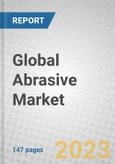The report contains comprehensive information regarding the abrasive industry and the users thereof. It includes details about various types of abrasives; materials used as abrasives; abrasive manufacturers’ most commonly used grains; manufacturers’ production with values; manufacturers of products using abrasive materials primarily for machine tools; users of abrasive tools and other applications; and users of loose abrasives. Estimated values are based on manufacturers’ total revenues. Projected and forecast revenue values are in constant U.S. dollars, unadjusted for inflation.
The abrasive market is segmented into the following categories:
- Type (abrasive grains and abrasive products)
- Application (buffing, honing, drilling, grinding, polishing, cutting, and sharpening).
- End use (metal manufacturing, automotive, electronics, medical, energy, building and construction, and wood and composites).
- Region: North America, Europe, Asia-Pacific (APAC), and the Rest of the World (RoW).
Report includes
- 45 data tables and 53 additional tables
- Overview and an up-to-date analysis of the global abrasives market with emphasis on materials, products and applications
- Analyses of the global market trends, with historical market revenue data (sales figures) for 2022, estimates for 2023, forecasts for 2027, and projections of compound annual growth rates (CAGRs) through 2028
- Estimate of the actual market size and revenue forecast for the global abrasives market in USD millions, and a corresponding market share analysis based on type, application, end-use industry, and region
- In-depth information (facts and figures) pertaining to the market growth drivers, challenges, opportunities and prospects; the technologies and regulatory scenarios; and the impacts of COVID-19 and the Russia-Ukraine war on the market
- Discussion of the importance of ESG in the global abrasives market, including consumer attitudes, an assessment of risks and opportunities, and the ESG practices followed by manufacturers and suppliers of abrasives
- Review of new and existing U.S. patents issued for abrasive technologies
- A look at the major vendors in the global market for abrasives, and an analysis of the structure of this industry with respect to company market shares, venture fundings, and recent mergers and acquisitions (M&A) activity
- Identification of the major stakeholders and analysis of the competitive landscape based on recent developments, key financials and segmental revenues, and operational integration
- Profiles of the leading market players
Table of Contents
Executive Summary
The refined abrasive grains segment is well concentrated globally, with a limited number of large companies that have grown successfully in the mass manufacture of grains with economies of scale. The products as such can be natural or synthetic, with natural referring to mined or to mined and processed products.
The users of abrasive grains, which manufacture products such as bonded grinding wheels or coated discs, far outnumber those that manufacture the grains. This user segment is more diverse in terms of regional diversity, and the companies are typically smaller in size than the grain manufacturers themselves.
Some global companies have operating divisions in both segments, and they are vertically integrated in this manner. However, even these companies often sell their grains to other product manufacturers.
End users of the abrasive industry are diverse. Automotive, metal manufacturing, and building and construction are the main users of abrasives and abrasive products. Niche segments that are smaller in terms of volumes but with relatively higher value include the medical, energy, and electronics industry, where abrasives are used for wafer slicing and cutting.
Market trends in the abrasive industry are closely tied to specific industries and overall economic climates in various countries. Industries can grow or contract drastically, as was seen during the housing (i.e., construction) boom in the U.S. during the early 2000s and the collapse that followed between 2007 and 2009. Such swings also provide opportunities for mergers and acquisitions for investors and companies with longer visions and more significant financial wherewithal.
The abrasive industry’s growth is close to global GDP growth, with higher GDP growth in developing countries and slower rates in developed countries. This is partly because the abrasive industry is closely tied to the manufacturing industry, yet it is disconnected from the service sector industry and only loosely tied to agrarian industries. Thus, the abrasive industry tends to play a greater role in a country’s total GDP when the country is going through a mechanization manufacturing-driven growth phase.
The GDPs of oil economies have a disproportionate dependence on industrial production. Countries such as Qatar, Iraq, the United Arab Emirates (UAE), Saudi Arabia, Oman, and Kuwait all have more than 50% of the country’s GDP coming from the industrial sector. Revival of the oil economies helps the abrasive industry, although, on a global basis, the GDPs of these countries have only modest shares.
Companies Mentioned
- 3M Co.
- Almatis GmbH
- Arc Abrasives Inc.
- Asahi Diamond Industrial Co. Ltd.
- Carborundum Universal Ltd.
- Dupont De Nemours Inc.
- Ehwa Diamond Industrial Co. Ltd.
- Fujimi Inc.
- Henkel AG & Co. Kgaa
- Robert Bosch GmbH
- Sak Industries Pvt. Ltd.
- Saint-Gobain
- Tyrolit-Schleifmittelwerke Swarovski AG & Co. Kg
Table Information
| Report Attribute | Details |
|---|---|
| No. of Pages | 147 |
| Published | September 2023 |
| Forecast Period | 2023 - 2028 |
| Estimated Market Value ( USD | $ 57.8 Billion |
| Forecasted Market Value ( USD | $ 74 Billion |
| Compound Annual Growth Rate | 5.1% |
| Regions Covered | Global |
| No. of Companies Mentioned | 13 |









